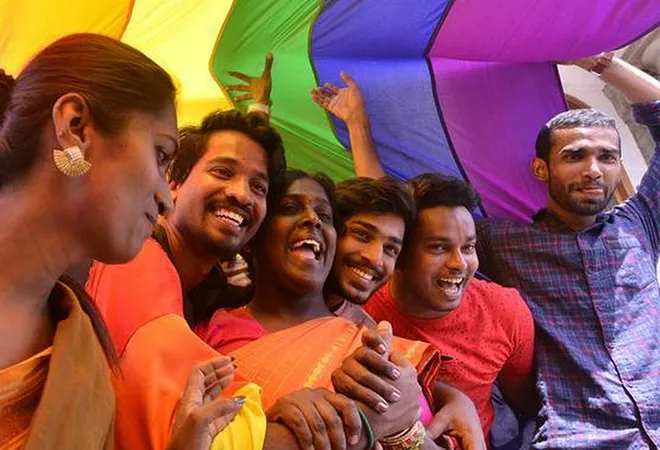
As June marks the beginning of the Global Pride Month, it not only celebrates equal rights and opportunities for LGBTQ communities, but also serves as a reminder of the discrimination that the community still faces. Breaking the Silence is the year’s theme, chosen to highlight LGTBQ people’s struggle against the stigma attached to their gender identities, sex characteristics or sexualities. The non-conformity of LGBTQ people challenges the traditional notions around family, kinship and nation. As a result, the community often faces social exclusion, leaving them disadvantaged and living on the margins. A study by the National Human Rights Commission (NHRC) of India found that about 99 percent of transgender people have experienced social rejections on multiple occasions. Moreover, 52 percent of the community has faced harassment by their school classmates and 15 percent from their teachers, resulting in their dropping out of school.
In India, significant progress has been made to protect the rights of the LGBTQ community in the last few years. On 15 April 2014, the Supreme Court legally recognised the rights and freedom of transgender people in National Legal Services Authority (NALSA) v. Union of India. On 6 September 2018, the Supreme Court also decriminalised same-sex relationships and struck down Section 377 of the Indian Penal Code. The recent Transgender Persons (Protection of Rights) Act, 2019, however, has raised several concerns regarding the status of transgender people in India. On 18 April 2020, the central government sought public feedback on the rules up to 18 May to implement the Act. Apart from certain provisions of the Act that may hinder the progress made for transgender rights, the public consultation process seems ill-timed considering the country-wide coronavirus lockdown. The lockdown has restricted the movement of the transgender community and made it difficult for them to discuss the rules and provide adequate feedback.
Transgender Persons Act 2019 versus NALSA judgement 2014
Under the NALSA v. Union of India ruling, transgender people were to be treated as a “third gender” and their rights safeguarded under the Constitution. It recognised that the self-identification of one’s gender is enough to provide rights to individuals. The supreme court also held that “sex” discrimination is not just limited to biological sex but also the “innate perception of one’s gender”, i.e. the gender that the trans individual identifies with. The court discussed gender identity at length and recognised its integral role in the formation of one’s individual personality and as a basic tenet to lead a life with dignity. Although a landmark judgement and an important milestone in the transgender community’s struggle for equal rights, it did not necessarily guarantee their equal treatment or provide directions for guaranteeing them a life of dignity.
In view of the 2014 judgement, the parliament introduced a series of bills addressing the rights of transgender people. The most recent one was introduced in July 2019, following which, it came to be known as the Transgender Persons (Protection of Rights) Act, 2019. The Act has received a negative response from the transgender community as it nullifies the NALSA judgement in their view. The new law is not only inadequate, they have claimed, but will also reverse the gains made to secure the rights of transgender people.
The NALSA ruling recognised the principle of ‘self-declaration’, sans any medical or psychological proofs, as the only legal gender identification required. The judgement had also held that any insistence on sex reconstruction surgery is immoral and illegal. This ruling was in line with international standards and best practices. United Nations, for instance, requires separation of medical and legal processes of gender reassignment for transgender people, including removal of evaluations from psychologists, physicians or other experts.
Under the Transgender Persons Act 2019, in order to legally recognise one’s transgender identity, the Act makes it mandatory for the individual to apply for a ‘Transgender Certificate’, which will label their gender as transgender. The new rules, however, requires the individual to submit a psychologist’s report for the ‘Certificate of Identity’. Moreover, if the individual undergoes surgery to change their gender to male or female, they require a ‘revised certificate’ issued by the District Magistrate. The District Magistrate has the power to judge the ‘correctness’ of the application, albeit if they are able to submit proof of their gender confirmation surgery. The draft rules make the process of gender identification and reassignment cumbersome and intrusive. The rules are unclear on how the accuracy will be judged. Moreover, it does not require the administrators to undergo any training in the subject matter. By including psychologists, medical proofs and district administrators, the rules not only exacerbate humiliation and invasive policing but also go against the right of “self-declaration” as recognised under the NALSA judgement.
Further, the Act states abusing transgender persons as a punishable offence with a jail term from six months to two years. The same crime against a cisgender (a person whose gender identity matches their sex at birth) woman can be a life sentence or even a death penalty. The provision of a lesser punishment reinforces the unequal status of the trans community. The Act is also unclear on the trans individuals’ access to welfare benefits and civil rights. The NALSA judgement directed the government to establish affirmative action measures in order to “increase the presence of transgender in educational institutions and public appointments”. The new rules, however, do not clearly state any provisions for affirmative action in education, healthcare and employment or civil rights related to marriage, adoption and property, etc.
Supporting inclusion
The diluted Transgender Persons (Protection of Rights) Act, 2019 does not take into account transgender community’s basic rights, bodily autonomy, dignity and goes against the very crux of the NALSA judgement. By subjecting them to psychological, medical and public authority’s scrutiny, it nullifies the right to self-determine one’s gender.
The judgements such as striking down of Section 377 by the Supreme Court, however, provide encouraging signs of the State’s approach in recognising diverse relationships and families. In order to safeguard the interests of the community, the Act must guarantee equal social, economic and civil rights as well as protection against abuse and discrimination. It is also essential to consult the transgender community before formalising the rules. The public consultation process must become more inclusive and provide sufficient time to discuss the rules. The state should consider extending the consultation procedure until the individuals can safely mobilise to effectively voice their concerns. Providing the transgender community equal constitutional rights is essential to empower them, reduce social stigmas and improve their socio-economic position.
The views expressed above belong to the author(s). ORF research and analyses now available on Telegram! Click here to access our curated content — blogs, longforms and interviews.




 PREV
PREV


